#Usipetes
Text
Cock Crazy Cougars Charlee Chase & Allura Skye Milk A Dick!
Asian Filipina Do Awesome Blowjob
Catwoman exchanges playing Horizon for hot rough self fuck with clamps on nipples and pussy
Horny School Slut Eliza Ibarra Fucks Teacher In Detention
Young boys fucking their fists and buff guys fisting gay xxx Fisting
coollege Hostel girl Hot video
Naked babe loves facesitting during cunilingus irrumation
BBW YOUNG PAWG SUCKS COCK POV
Every boss needs an employee like Chanel Preston
Lucky B on the Party Bus
#reserves#nonstrikers#outflanking#endorsing#sceptering#Usipetes#bittie#multibreak#kagus#magicalparadisefestival#penintime#stereogastrula#not-#Factor#Bhumij#undefrauded#upperworks#tabidness#self-complaisance#Cariamae
1 note
·
View note
Text
"Cæsar, to spread devastation more widely, divided his eager legions into four columns, and ravaged a space of fifty miles with fire and sword. Neither sex nor age moved his compassion. Everything, sacred or profane, the temple too of Tamfana, as they called it, the special resort of all those tribes, was levelled to the ground. There was not a wound among our soldiers, who cut down a half asleep, an unarmed, or a straggling foe. The Bructeri, Tubantes, and Usipetes, were roused by this slaughter, and beset the forest passes through which the army had to return."
FUCKING DAMMIT
#WON'T SOMEONE THINK ABOUT THE FUTURE SCHOLARS#or people who just think this is intresting#AAAAAAAAGH THIS MAKES MY JOB SO MUCH HARDER#germanic mythology#germanic goddess#germanic god#germanic paganism#pagan#paganism
10 notes
·
View notes
Photo

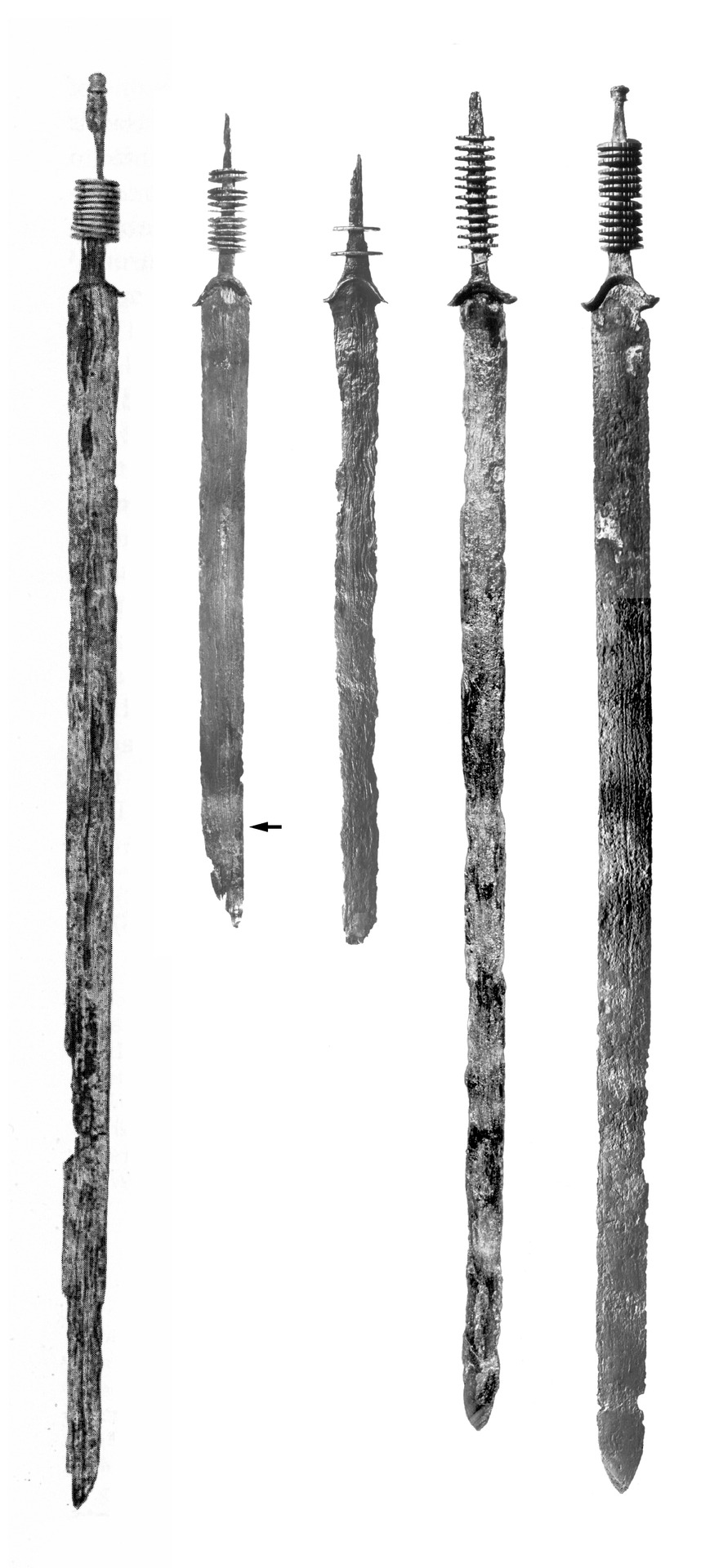

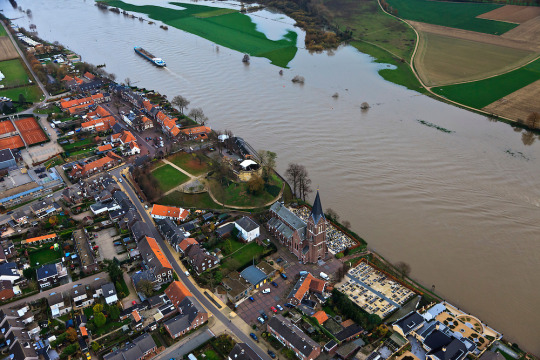
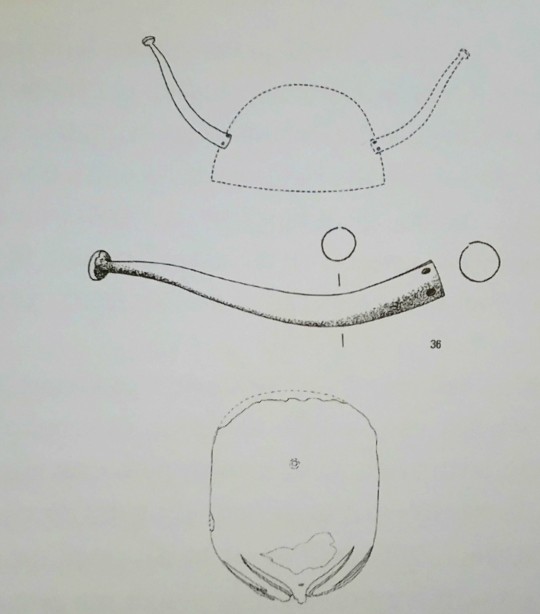
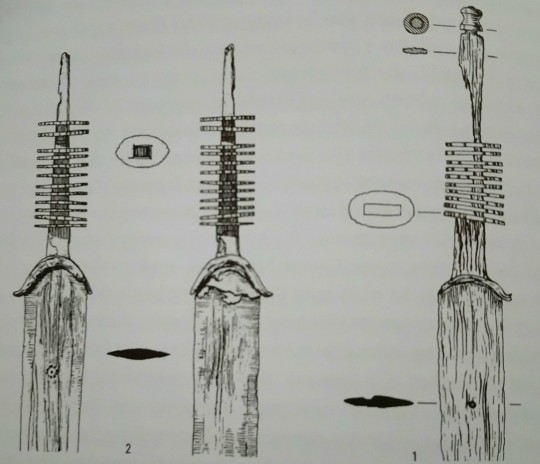
Massacre at the river Maas
When the Germanic people invaded Gaul in 55BC, Caesar saw this as an opportunity to present himself as the 'protector' of the Gauls. He sent eight legions and the upcoming battle would result in the biggest slaughter of the entire Gallic war which I briefly wrote about in my post about the Tencteri last September.
The Tencteri and the Usipetes crossed the Rhine in 55BC searching for new lands to settle. The tribes appealed to Caesar for asylum but it was refused. The two parties met for negotiations during which the Germanics asked for three days time in order to send envoys to the nearby Ubii. Caesar however believed that the Germanics were only buying time to regroup their cavalry.
Caesar decided to attack the Germanic camp instead to the great surprise of the Germanics. Chaos ruled in the camp as the Romans attacked the unaware Germanics, they stood no chance to win so many started to flee towards the river. The Romans chased them down and killed as many as they could.
Caesar even seemed proud in his work when he described how his men killed every woman and child that they could find. Some fled into the river Maas but the current was strong so they got either killed by the river or by Roman troops.
The exact amount of people killed is unknown but we do know that Caesar's numbers are way too exaggerated. He claimed that he destroyed a population of 430,000 people. This however seems unlikely since there weren't that many people living in the low countries around 55BC. An estimated guess of the amount of people killed now lies around 150,000 people. A true genocide that took place in the Netherlands.
Napoleon III wrote a book about Julius Caesar in 1865 and mentioned that this particular battle must have taken place around fort Sint Andries near Heerewaarden, the Netherlands. This fort was strategically placed between the rivers Maas and the Waal which agrees with Caesar's comment on how the battle took place on the spot where the Maas and the Waal flow together.
In 1975, during dredging work, several artifacts were found at this spot which date from Caesar's time. This only seemed to confirm the suspicion that the battle took place here. But because not all found objects date from this time period, many archeologists had their doubts.
Another more possible location is the Dutch place of Kessel. Several belt hooks, swords, spearheads, a helmet and human remains were dredged out of the river Maas that belong in the same time period as the battle took place. According to Roman sources, Kessel lies 80 Roman miles away from the North sea, the same distance that is also mentioned by Caesar.
The human remains found at Kessel belonged to 70 individuals, 8 of these bones show signs of trauma, per example a skull with a hole near the left eye socket caused by a spear, this skull belonged to a 40-60 year old woman. Another skull shows an axe injury and a third skull has a sword injury. Many of the remains belonged to women and children which fits the narration of Caesar.
Here are photos of:
Human remains found
Drawings of the found helmet and Germanic cavalry swords
A depiction of the battle by an unknown artist
Kessel in the 21st century
20 notes
·
View notes
Text
Location of Caesar’s genocidal slaughter announced
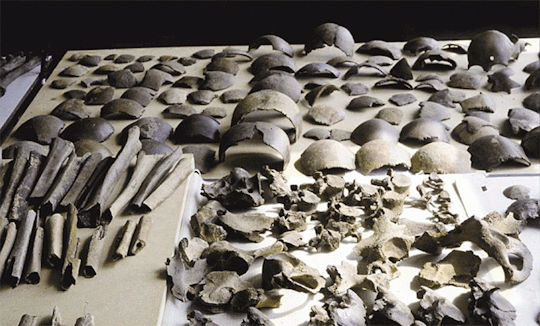
Archaeologist Nico Roymans from VU University Amsterdam, announced the probable location where Julius Caesar in 55 BC annihilated two Germanic tribes. Caesar wrote at length in Book IV of his De Bello Gallico of the events surrounding the slaughter. The conclusions reached by the archaeologists are based on a combination of historical, archaeological and geochemical data.
The Tencteri and Usipetes were two Germanic tribes who came from an area east of the Rhine. Their request for asylum in new territory was refused, and Caesar with his full force of eight legions and cavalry went to war against them. After the conquest the fleeing remaining population was pursued by Roman troops. Read more.
315 notes
·
View notes
Photo

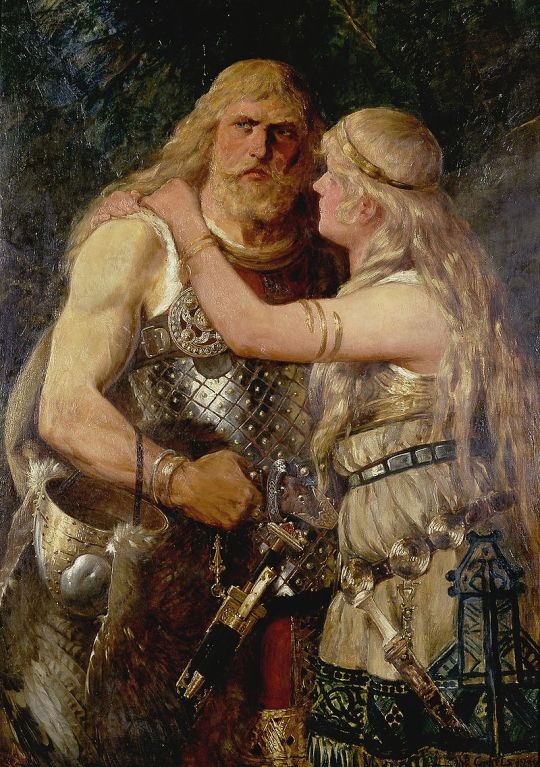

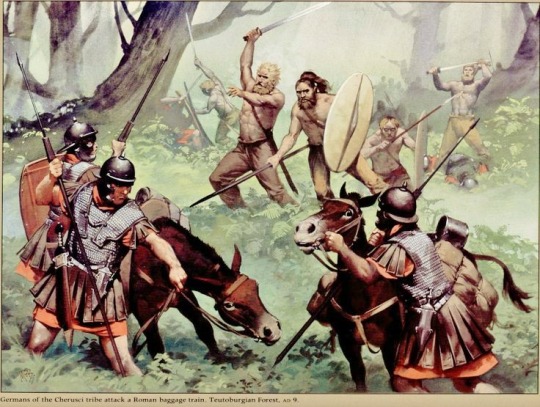
Cherusci
The Cherusci were a Germanic tribe from modern day northwestern Germany, around the northern Rhine valley. They are perhaps the best known tribe of all the Germanic tribes thanks to the famous battle of Teutoburgerwald and their leader Arminius. To the west they were neighboured by the Bructeri and Chattuarii, to the east by the Semnones, to the south by the Chatti and to the north by the Angrivarii and the Chauci.
The meaning of their name is still somewhat unclear. There are in fact two possible theories: the first suggests that their name is derived from the Proto-Germanic word ‘Herut’ which means hart or deer. The other theory suggests that the name comes from the name Germani, given to the Germanic people by the Romans who in turn based this word on the words they heard the Germanic people using to describe themselves, its meaning is spearmen. The Cherusci might very well be named after ‘Herman’, German/Germani.
The first mention of this tribe comes from Julius Caesar in 53BC in his work ‘De Bello Gallico’. Caesar crossed the Rhine in order to punish the Suebi for aiding the Celtic tribes in Belgae, this is when he encountered the Cherusci tribe for the first time. Interestingly, Caesar noted that the Cherusci were not part of the Suebi and are separated from them by the Bacenis forest, a dense wood that was near impenetrable.
I have mentioned the expeditions of Nero Drusus Germanicus before in several other posts. His campaigns into Germania, between 12BC-9BC, were incredibly succesfull. He sugjugated tribes such as the Batavi, Frisii, Marsi, Chauci, Mattiaci, Marcomanni, Usipetes and the Cherusci. He was well under way in conquering all of Germania for the Roman empire, just like how Gaul became a Roman province. He would have suceeded if a fall from his horse in 9BC didn’t kill him.
A few years later around 7AD-8AD, the now famous Arminius returned to Germania after having led a Cherusci regiment of auxiliary cavalry during the Pannonian wars in the modern day Balkan region. Arminius himself was the son of the Cherusci chief who was made a hostage of Rome after the succesfull campaigns of Drusus Germanicus. He grew up in Rome and even became a Roman citizen. He returned to Germania to aid the local governour, Publius Quinctilius Varus in conquering the rest of the Germanic tribes. It was during this period that Arminius secretly switched sides and plotted the unification of several Germanic tribes in order to thwart Rome’s plans for an expansion into Germania.
This would have been one hell of a task since the Germanic tribes were constantly at war with each other throughout history. Uniting them would take a lot of patience and a skilled charismatic leader, fortunately for Arminius he was the right kind of leader and he managed the impossible, the military unification of several Germanic tribes. Arminius decided to wait for the perfect moment to strike at the Romans. This perfect moment arrived in 9AD when most of the stationed legions, 8 out of the 11, were sent away to crush a rebellion in the Balkans. Varus was now left with only three legions.
Arminius set up a trap for Varus and his men by sending him false reports of a non-existing rebellion in the north. Varus apparently trusted Arminius and sent his three legions plus auxiliary detachments up north near modern day Kalkriese, Germany. When they arrived there, they were attacked by Arminius and his allied tribes, which was the start of the famous Teutoburgerwald battle. The Romans were completely surprised by the attack and Varus’ three legions were completely annihilated, about 20,000 Roman soldiers were slaughtered and Varus himself committed suicide.
This battle was the biggest defeat in Roman military history. Several Roman fortifications along the Rhine were abandoned after the battle, its people fleeing back to Gaul out of fear for more Germanic attacks. The Romans were absolutely shocked to the core at the loss of three of their prized legions and quickly called for revenge. Never before had Rome been bested on such a large scale by mere ‘barbarians’. The loss was especially hard on the Roman emperor of that time, Augustus. It is said by Roman historian Suetonius that Augustus refused to cut his hair or beard for months after hearing the news, a sign of mourning. He also spoke the legendary sentence: “Quinctilius Varus!, give me back my legions!”.
Emperor Augustus died a few years later in 14AD and was succeeded by his adopted stepson, Tiberius who planned an expedition into Germania to punish the tribes who were involved in this legendary defeat. It was between the years 14AD-16AD that general Germanicus Julius Caesar led this punal campaign in order to punish the Germanic people and retrieve the three eagles which were lost during the battle. This campaign eventually led to three expeditions which were succesfull for Rome, they managed to retrieve two of the lost eagles and laid waste to several of the involved tribes. No mercy was shown by these Roman soldiers, they burned and killed everyone and everything on their path including women and children.
During this period, Arminius revived his military alliance and laid siege on Segestes, whose daughter was married to Ariminius. The Romans were however able to relieve Segestes and capture his pregnant daughter, Thusnelda. Arminius’ son was born in Rome and trained to be a gladiator, he unfortunately died in combat before the age of 20. The Germanic tribes were soundly defeated during this revenge campaign but emperor Tiberius had lost his ambitions for turning Germania into a Roman province, fearing more future rebellions. He eventually abandoned Germania and established permanent borders along the Rhine, he had his eyes now on a new land to conquer, a land, he hoped, that wouldn’t fight back so fiercely, Britannia.
This didn’t mean that peace returned to the Cherusci tribe. Arminius decided to attack Maroboduus, leader of the Marcomanni, for their refusal to fight against the Romans. This led to a two year war between 17AD-19AD which ended indecisively but the Marcomanni retreated back into territory that later became Bohemia. Arminius himself, who gained immense populairy and power after the victory of Teutoburgerwald, was assassinated by his own nobles in 21AD who felt that Arminius was getting too powerful.
Not much is known about the Cherusci after the events of the Teutoburgerwald battle and Arminius’ life. They continued waging war with neighbouring tribes, including the Chatti. This was of course not uncommon since the Germanic tribes were always at war with each other, they were only able to unite when they had a common foreign enemy. In 98AD Tacitus published his work Germania and added a description of the Cherusci:
"Dwelling on one side of the Chauci and Chatti, the Cherusci long cherished, unassailed, an excessive and enervating love of peace. This was more pleasant than safe, for to be peaceful is self-deception among lawless and powerful neighbours. Where the strong hand decides, moderation and justice are terms applied only to the more powerful, and so the Cherusci, ever reputed good and just, are now called cowards and fools, while in the case of the victorious Chatti success has been identified with prudence. The downfall of the Cherusci brought with it also that of the Fosi, a neighbouring tribe, which shared equally in their disasters, though they had been inferior to them in prosperous days."
- Tacitus (It sounds a bit salty in my opinion)
Eventually the Cherusci were absorbed into the Saxon and Frankish confederation by the third century AD, this is the moment when they disappeared from history as an identity. The Cherusci might have even played an important factor in the formation of the Saxons but how big this role exactly was, is unknown. What is known is that the Cherusci left an important Germanic legacy behind, the battle of Teutoburg forest. Some historians call this the most important battle of Germanic/Roman history and the biggest military loss of the Roman empire. It had huge political consequences afterwards such as the permanent withdrawal of Romans in Germania and the abandoning of all plans to conquer the land for Rome.
Here are images of:
A map showing the location of the tribe.
A painting of Arminius by Johannes Gehrts (1884) made in the 19th century during which the rivival of Germanic mythology began.
A depiction of the Teutoburgerwald battle, artist unknown.
A statue of Arminius located south of Detmold, Germany.
69 notes
·
View notes
Photo


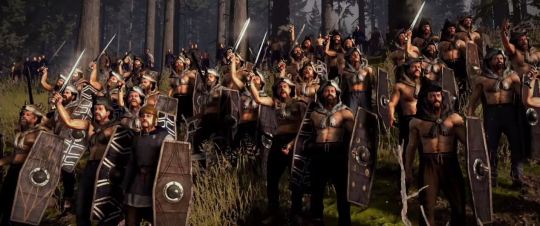
Chatti
The Chatti were a Germanic tribe located in modern day Hesse and southern Saxony, Germany. They were one of the largest and most powerful tribes of Germania, only the Cherusci were as large as the Chatti tribe. I have written a post about this tribe last year but I wanted to add more information and of course this group has gained so many new members since last year, that most probably missed my previous post on this tribe. Also thanks to Netflix’ new show ‘the Barbarians’ the Chatti has gained more attention. Somewhere around 100BC, there was a huge internal conflict in the Chatti tribe, this conflict resulted in the split of the tribe. Two groups of Chatti tribesmen/women migrated towards the lower Rhine area in modern day Netherlands, this is how the Batavi and Cananefates were born.
The meaning of the tribe’s name isn’t 100% certain but most theories lead to the following meaning: ‘the angry’ or ‘the haters’ from the Proto-Germanic word Hataz. If this is the correct meaning of their name, it is quite a curious one. Why would a tribe call themselves like that? It might have something to do with a conflict that they experienced with another tribe or the conflict that caused the tribe to split back in 100BC. Perhaps the tribe’s name isn’t Germanic in origin at all. Another theory suggests that the word Chatti comes from the Proto-Celtic word Cat which means ‘battle’ or ‘fight’. If this is the case, the pronunciation is also different ‘Khatti’. Yet again these are just theories and nothing is 100% certain. The modern day region of Hesse, where the Chatti once lived, has most likely been named after the tribe.
The first written records about this tribe came from Nero Claudius Drusus Germanicus, the stepson of emperor Augustus. After Germanicus was appointed as the governour of Gaul, he launched a series of campaigns into Germania in an attempt to conquer Germania just like how Gaul was conquered and added to the Roman empire. The first of his campaigns started in 12BC and was very succesful for Germanicus. He crossed the Rhine with his army and subjugated the Sicambri tribe. Germanicus was also the first Roman to reach the Weser river in northern Germany, close to modern day Denmark.
During a later campaign in the same year, he also subjugated the Batavi and the Frisii and defeated the Chauci at the river Weser. In the following year, 11BC, Germanicus defeated the Marsii, Bructeri and the Usipetes. From 10-9BC Germanicus also defeated the Chatti, Cherusci and Marcomanni. It seems as though nothing could stop him from conquering all of Germania, he almost succeeded at this until a fall from his horse during his fourth campaign killed him. It is likely that Germania would have become a Roman province if Germanicus didn’t fell off his horse.
It was during Drusus Germanicus’ campaigns that the famous Arminius of the Cherusci was sent to Rome as tribute by his father, together with his brother Flavus. Relationships between the Cherusci and the Romans continued to sour in the following years after their defeat by the Romans during Germanicus’ campaigns. This eventually led to Arminius revolting against the Romans in 9AD. The king of the Chatti, Adgandestrius, was quick to join Arminius. The Chatti also haven’t forgotten Germanicus’ campaigns in Germania. The revolt led to the famous Teutoburgerwald battle during which three Roman legions were completely destroyed
This battle would be the biggest military defeat for Rome. While Germanicus almost succeeded at conquering Germania, this battle led to the abandonment of all plans to expand the Roman empire into Germania. Permanent borders were established along the Rhine river which kept Germania free. Interestingly enough, Adgandestrius turned against Arminius in 19AD. He even went as far as to ask Rome for help in assassinating Arminius with poison. This request was denied by the Romans as they saw this as a dishonourable way to defeat Arminius, the Romans prefered to meet him in battle. Arminius died two years later, betrayed and murdered by his own people who thought that Arminius was getting way too powerful. (Hope I didn’t just spoil the show for you guys, I still haven’t watched it)
Almost half a century later, another conflict broke out, this time between the Chatti and the Hermunduri in 58AD. Both tribes fought for control over a river that was rich in salt that flowed between the two tribes. This whole conflict has been recorded by Tacitus who described that this river was also very religiously important to the Germanic people. It is not certain which river is mentioned by Tacitus, it is either the Rhine or Main (a river connected to the Rhine). The Germanic people believed that this river was closely connected to the realm of the Gods. If you would make a prayer at the banks of the river Rhine, it would be directly received by the Gods. Both tribes also vowed their enemies to Tyr and Wodan before the battle started. This vow meant that the defeated party was sacrificed to Tyr and Wodan, unfortunately for the Chatti, they lost this battle.
Another revolt broke out in 69AD, this time the Batavi revolted against the Roman empire. The Chatti also joined this rebellion, even though the Batavi were once part of the Chatti and left due to a conflict. The Batavi were able to destroy two Roman legions and several Roman fortifications before the revolt was put down. The Chatti laid siege to Mogontiacum, modern day city of Mainz. Even though the Romans lost their trust in the Batavi, they recognized their strong fighting power and are named the strongest of all the Germanic tribes, not in number but in skills.
20 years later in 89AD, the Chatti joined another revolt. This time two Roman legions under Antoninus Saturninus revolted against emperor Dominitan. Unfortunately all documents describing this event are lost or destroyed so we can sadly never know what event led to two Roman legions revolting against their emperor. There is a theory that the revolt was caused by Dominitan’s strict moral policies for the officers of the army. The revolt however failed before it could really begin. It would have been interesting to observe this revolt if it had succeeded, a curious sight Romans and Chatti warriors fighting side by side.
In 98AD Tacitus published his famous work the Germania, in this work he describes the Chatti as following:
“Beyond these dwell the Chatti, whose settlements, beginning from the Hercynian forest, are in a tract of country less open and marshy than those which overspread the other states of Germany, for it consists of a continued range of hills, which gradually become more scattered and the Hercynian forest both accompanies and leaves behind, its Chatti.
This nation is distinguished by hardier frames, compactness of limb, fierceness of countenance, and superior vigor of mind. For Germanics, they have a considerable share of understanding and sagacity, they choose able persons to command, and obey them when chosen, keep their ranks, seize opportunities, restrain impetuous motions, distribute properly the business of the day, intrench themselves against the night, account fortune dubious, and valor only certain, and, what is extremely rare, and only a consequence of discipline, depend more upon the general than the army.
Their force consists entirely in infantry who, besides their arms, are obliged to carry tools and provisions. Other nations appear to go to a battle, the Chatti, to war. Excursions and casual encounters are rare amongst them. It is, indeed, peculiar to cavalry soon to obtain, and soon to yield, the victory. Speed borders upon timidity slow movements are more akin to steady valor.
A custom followed among the other Germanic nations only by a few individuals, of more daring spirit than the rest, is adopted by general consent among the Chatti. From the time they arrive at years of maturity they let their hair and beard grow and do not divest themselves of this votive badge, the promise of valor, till they have slain an enemy. Over blood and spoils they unveil the countenance, and proclaim that they have at length paid the debt of existence, and have proved themselves worthy of their country and parents. The cowardly and effeminate continue in their squalid disguise.
The bravest among them wear also an iron ring (a mark of ignominy in that nation) as a kind of chain, till they have released themselves by the slaughter of a foe. Many of the Chatti assume this distinction, and grow hoary under the mark, conspicuous both to foes and friends. By these, in every engagement, the attack is begun: they compose the front line, presenting a new spectacle of terror. Even in peace they do not relax the sternness of their aspect. They have no house, land, or domestic cares, they are maintained by whomsoever they visit, lavish of another's property, regardless of their own till the debility of age renders them unequal to such a rigid course of military virtue.” – Tacitus
Not much is further known about the Chatti besides the fact that they raided Roman territory between 160-170AD. Eventually elements of the Chatti, together with the Batavi, Cherusci, Tencteri, Tubantes, Chamavi, Bructeri, Sicambri and the Ampsivarii formed together in a confederation called the Franks. They settled in modern day southern Netherlands and Belgium around 300AD and were first of the Franks who eventually founded modern day France. The remaining Chatti remained in their original location and continued raiding the Romans wherever they could, by 300AD the Roman western borders were severely weakened by internal conflicts.
Eventually the remaining Chatti became the Hessi during the early medieval ages, this was first recorded in 782AD. Hesse itself has a long and rich history but that is not a topic for this group, feel free to explore this topic further if you are interested in Hesse’s history.
Here is a map which shows the location of the Chatti, a map showing Roman campaigns into Germania before the Teutoburgerwald battle and a depiction of Germanic warriors from the game Rome 2 total war.
39 notes
·
View notes
Photo
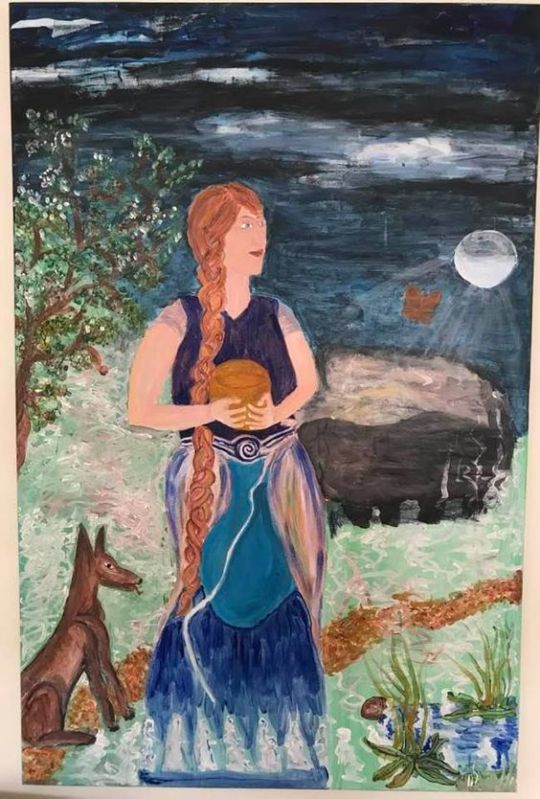

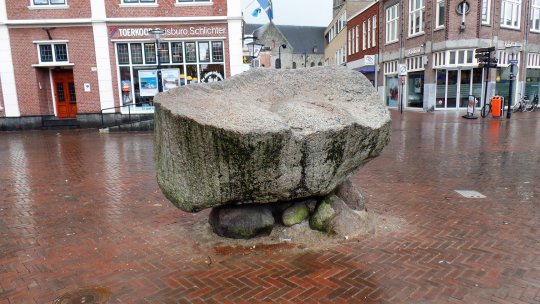
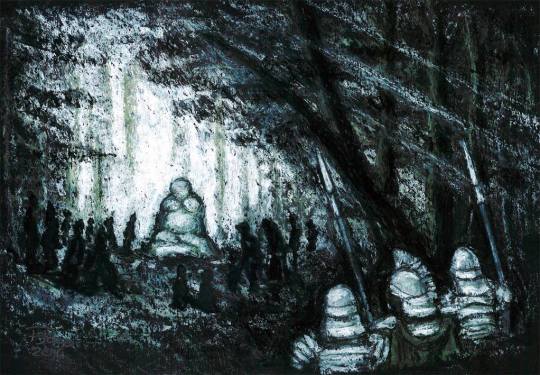
Tanfana
Tanfana is a local Germanic Goddess who was worshipped in modern day Germany and the Netherlands. She has been mentioned by Tacitus in his work the annals. Besides Tacitus' mention and a few local legends, little is known about this Goddess. The meaning of her name still remains a debate, it could have been derived from the Proto-Germanic word Tafnano meaning 'Goddess of the sacrificial animal'.
Tacitus mentions a slaughter and the destruction of Tanfana's temple in the annals book 1 chapter 51:
"Cæsar, to spread devastation more widely, divided his eager legions into four columns, and ravaged a space of fifty miles with fire and sword. Neither sex nor age moved his compassion. Everything, sacred or profane, the temple too of Tanfana, as they called it, the special resort of all those tribes, was levelled to the ground. There was not a wound among our soldiers, who cut down a half-asleep, an unarmed, or a straggling foe. The Bructeri, Tubantes, and Usipetes, were roused by this slaughter, and they beset the forest passes through which the army had to return."
The location of this mentioned Tanfana temple is not 100% certain but theories suggest that this temple was perhaps located on the Tankenberg, the Netherlands. The mayor of Brinkhorst placed this quote of Tacitus on top of the Tankenberg in 1844 as a nod to the Goddess Tanfana. Other theories suggest that this temple must have been located somewhere between the rivers Ruhr and Lippe in modern day Germany.
But who is Tanfana exactly? Tacitus described that this slaughter took place 5 years after the historical defeat at the battle of Teutoburgerwald. It was general Germanicus, cousin of the emperor Tiberius, who attacked the Marsi tribe and committed this slaughter. Germanicus attacked the Marsi while they were preparing a big feast in honour of the Goddess Tanfana.
By looking at the date of the slaughter, on a full moon somewhere around the equinox in the year 14AD, possible around 24/25th September, we can guess that Tanfana might be a Goddess of fertility since September is a harvest month. The Marsi could have held this feast in order to thank Tanfana for the succesfull harvest. During this feast, animals were sacrificed on a big sacred stone, if the temple was indeed located on the Tankenburg, it could have been the sacred stone which is still visible these days on the market of Oldenzaal.
Unfortunately with the arrival of the Christians a few centuries later, Tanfana had to be erased from history. So she was, like many other deities and beings, demonized by the church. Tanfana was depicted as an evil old witch known in the Dutch child rhyme: Anneke, Tanneke, Toverheks. This rhyme is sung by children sitting in a circle, one of the children plays as the witch Tanneke while another plays as a dog who has to catch the witch. Tanfana, according to the church, would eat small children and sacrifice them to the devil himself.
Tanfana is certainly an interesting Goddess who had to suffer the wrath of the Romans after they lost several legions in the famous Teutoburgerwald battle in 9AD. A Goddess of fertility and harvest with similarities to Nerthus sadly demonized by the church.
Here are pictures of:
Modern day depiction of Tanfana by Anneke Wittermans,
Tankenberg with Tacitus' quote in the Netherlands,
The Tanfana stone now located in Oldenzaal,
Romans approaching Tanfana's temple art by Polly,
46 notes
·
View notes
Photo

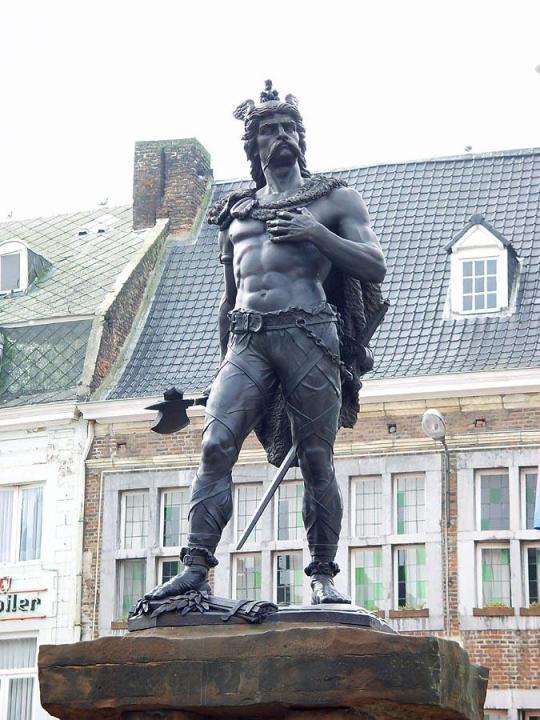

Eburones
The Eburones were a Celtic tribe but with Germanic influences, although Julius Caesar described them as being Germanic. They lived between the river Rhine and the Maas in modern day southern Netherlands and northern Belgium. Their name, if it is Celtic, means yew. Yew trees and wood was seen as sacred by the Germanic tribes of modern day Netherlands, almost all runic inscriptions have been found on yew wood.
Despite Caesar claiming they were Germanic, all evidence leads to them being Celtic in origin. Their close location to the Germanic tribes may have led to Germanic influences but judging by their name and archeological finds, they are Celtic. It is often hard to define which Belgic tribes are Celtic or Germanic since most of them have mixed ethnicities.
Not much is known about the Eburones except for what Caesar described. We do know they had a sacred place at Empel which I described before in a post about the Empel temple. During Caesar's invasion of Gaul, the Belgic tribes allied themselves against the Romans, this included the Eburones.
In 55BC, the Germanic tribes of the Usipetes and the Tencteri tried to settle on new land after being driven away by the Suebi. These two tribes eventually bumped into the Belgic Menapii tribe and attacked them. Not only do they attack the Menapii, they also attack the Eburones and the neighbouring Condrusi. Caesar moved north to deal with this Germanic threat on Celtic lands and manages to free the leader of the Eburones, Ambiorix.
However in 53BC, Ambiorix and Cativolcus instigate a revolt. The Eburones with the help of the Treveri manage to destroy a Roman legion under Quintus Titurius Sabinus and Lucius Aurunculeius Cotta, both Roman generals die in this conflict as well. The surviving Roman forces committed suicide in order to avoid capture by the Celts. In all about 8000 Romans were killed.
Ambiorix proudly marched towards the Atuatuci after this victory, a tribe about whom I wrote a post a few weeks ago, and encouraged them and the Nervii to join the Eburones against the Romans. This alliance attacked a legion of Cicero. Julius Caesar makes his way to Cicero with 7,000 of his men when they are attacked by 60,000 Gauls.
Unfortunately the battle turned sour for the Eburones and they are defeated by Caesar. Ambiorix flees and Cativolcus commits suicide. Caesar then burned down every village of the Eburones, killed countless of people, stole their crops and so eventually destroyed the tribe. Surviving members most likely joined neighbouring tribes. The land itself was resettled by the Germanic Tungri.
Here are photos of:
A statue of Ambiorix in Tongeren, Belgium
A map which shows the location of the tribe
And a reconstruction of how an Eburonus warrior would have looked like
48 notes
·
View notes
Photo

The First Crossing Of The Rhine (55BC)
This small piece from Caesar's work 'De Bello Gallico', describes how Caesar crossed the Rhine, the first Roman to do so, he didn't spend a long time in Germania, he left after 18 days when he heard the Suebi were gathering a large army. Yet in these 18 days, Caesar managed to commit several war crimes like burning down villages and destroying crops.
"On the conclusion of the Germanic war, Caesar thought it advisable for several reasons to cross the Rhine. His strongest motive was to make the Germanics less inclined to come over into Gaul by giving them reason to be alarmed on their own account, and showing them that Roman armies could and would advance across the river.
Another consideration was that the cavalry division which, as mentioned above, the Usipetes and Tencteri sent across the Meuse in quest of plunder and corn, having taken no part in the battle and retired over the Rhine after the rout of their fellow countrymen, entered the territory of the Sugambri and joined forces with them.
And when Caesar sent an embassy to the Sugambri to demand the surrender of men who had made war on him and Gaul, they answered that the Rhine was the limit of Roman sovereignty. If Caesar held that the Germanics had no right to cross into Gaul against his wishes, how could he claim any dominion or authority beyond the Rhine?
A third reason was that the Ubii, the only people in Germania who had sent envoys to Caesar, entered into alliance with him, and given hostages, were earnestly entreating him to come and defend them from the oppression of the Suebi or merely to bring his army across the river, which would suffice to deliver them from immediate danger and assure their security for the future. For these reasons Caesar had determined to cross the Rhine, but a crossing by means of boats seemed to him both too risky and beneath his dignity as a Roman commander.
Ten days after the collection of timber had begun, the work was completed and the army crossed over. Leaving a strong guard at each end of the bridge, Caesar marched into the territory of the Sugambri. Meanwhile a number of tribes sent envoys with requests for peace and friendship, which Caesar graciously granted, bidding them bring hostages.
But the Sugambri, who as soon as the construction of the bridge was begun had been advised by the fugitive Usipetes and Tencteri to prepare for a flight, had left their country with all their belongings and hidden themselves in forests and uninhabited districts.
Caesar remained for a few days in their territory, burning all the villages and farm buildings and cutting down the crops, and then returned to the Ubii, to whom he promised help if they were molested by the Suebi. They informed him that the Suebi, on learning from their scouts that a bridge was under construction, had convened a council, their usual procedure in such cases, and sent out word in all directions that the people should abandon their towns and hide their wives and children and property in the forests.
All men capable of bearing arms had been ordered to assemble in one place, almost exactly in the middle of their territory. There they were awaiting the Romans, and had determined to fight a decisive battle on the spot. On receiving this news, Caesar recrossed the bridge into Gaul and destroyed it behind him.
He had achieved all the objects for which he had come, to overawe the Germanics, punish the Sugambri, and relieve the Ubii from the harassing pressure of the Suebi, and after spending a total of eighteen days across the Rhine, he considered that he had done all that honour or interest required."
- Julius Caesar, De Bello Gallico
(And yes, Caesar wrote about himself in the third person in his book on the conquest of Gaul. It might have been the custom to do so centuries ago but nowadays it looks quite awkward.)
Here is a depiction of Julius Caesar crossing the Rhine, on his self made bridge, with his army by John Soane (1814).
26 notes
·
View notes
Photo
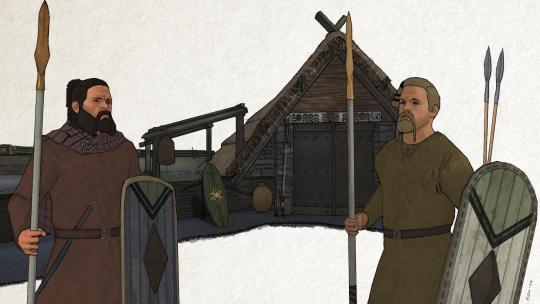
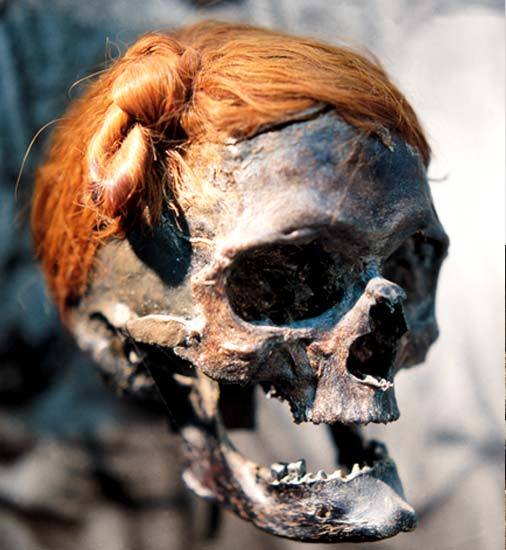
Here is a piece written by Julius Caesar on the Suebi.
"In the following winter, in which the consulship of Pompey and Crassus began, the Germanic tribes of the Usipetes and Tencteri crossed the Rhine in large numbers not far from its mouth. They were forced to migrate because for several years they had been subjected to harassing attacks by the Suebi and prevented from tillng their lands.
The Suebi are by far the largest and most warlike of the Germanic nations. It is said that they have a hundred cantons, each of which provides annually a thousand armed men for service in foreign wars. Those who are left at home have to support the men in the army as well as themselves, and the next year take their turn of service while the others stay at home.
Thus both agriculture, military instruction and training continue without interruption. No land however is the property of private individuals and no one is allowed to cultivate the same plot for more than one year.
They do not eat much cereal food, but live chiefly on milk and meat, and spend much time in hunting. Their diet, daily exercise and the freedom from restraint that they enjoy, combine to make them strong and as tall as giants. They inure themselves in spite of the very cold climate in which they live, to wear no clothing but skins and these so scanty that a large part of the body is uncovered and to bathe in the rivers.
Traders are admitted into their country more because they want to sell their booty than because they stand in any need of imports. Even horses, which the Gauls are inordinately fond of and purchase at big prices, are not imported by the Germanics. They are content with their home-bred horses, which although undersized and ugly, are rendered capable of very hard work by daily exercise.
In cavalry battles they often dismount and fight on foot, training the horses to stand perfectly still, so that they can quickly get back to them in case of need. In their eyes it is the height of effeminacy and shame to use a saddle and they do not hesitate to engage the largest force of cavalry riding saddled horses, however small their own numbers may be. They absolutely forbid the importation of wine because they think that it makes men soft and incapable of enduring hard toil.
They regard it as the proudest glory of a nation to keep the largest possible area round its frontiers uninhabited, because it shows that many other peoples are inferior to it in military might. It is said for example that on one side of the Suebic territory the country is uninhabited for a distance of more than 885km.
On the other side their nearest neighbours are the Ubii, who were once by Germanic standards, a considerable and prosperous nation. They are somewhat more civilized than the rest of the Germanics, for living on the Rhine so close to the frontier of the Gaul, where traders visit them regulary, they have adopted Gallic customs.
The Suebi, after repeated attempts to oust them from their home by force of arms, found them too numerous and strong to be dispossessed but compelled them to pay tribute and greatly reduced their pride and power."
-Julius Caesar, De Bello Gallico
Here is a depiction of two Suebi warriors preparing for a raid by an unknown artist, if you know the artist, let me know. And a photo of a mummified Suebi head found in Osterby, Germany which shows the classic Suebi hair style.
25 notes
·
View notes
Photo
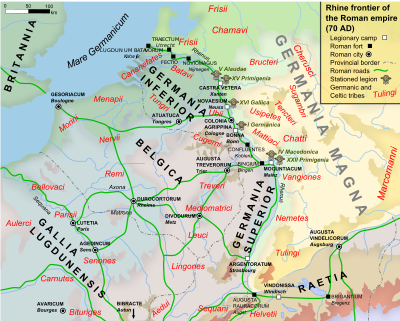
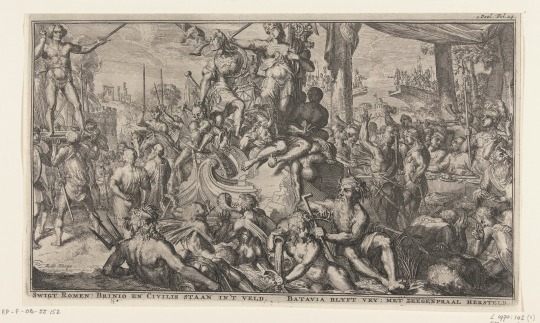
Cugerni
The Cugerni were a Germanic tribe with possible Belgic origins who were located in modern day southern Belgium and Northern France, basically between the river Maas and the Rhine.
Their name most likely is Celtic in origin and might mean 'spears together'. This translation is however quite uncertain just like the origin of the tribe is. The people of the Cugerni tribe might have splitted from the Sicambri tribe or they are left-overs from the Teutonic migration, if this is true, they are Germanic in origin. We can only tell that the tribe formed around 100BC.
Since this tribe was relatively small, little is known about them. During Caesar's campaign in Gaul, he utterly destroys a Germanic tribe, the Atuatuci, about which I wrote a post several weeks ago. Some survivors of this tribe might have possibly joined up with the Cugerni. This is however uncertain but possible.
Nothing more is known about this tribe except their involvement in the Batavi uprising in 69AD. The Cugerni, together with the Canninefates, Chauci, Tencteri, Bructeri and Sinuci join the Batavi in their revolt and manage to defeat two Roman legions. Later they were joined by the Chatti, Usipetes and Mattiaci and they besieged a Roman fort, Mogontiacum, now known as Mainz.
Eventually the revolt was put down by the Romans and the leader of the rebellion, Civilis, retreated back into Batavi lands and made peace with the Romans, to be precise, with general Quintus Petilius Cerialis. The Batavi were treated well after this revolt, even serving as the imperial bodyguard.
The Cugerni themselves were eventually absorbed into the Roman empire after permanent borders were established along the Rhine river. The Cugerni lived in Gaul territory which became a Roman province. It is quite possible that the tribe was raided several times by invading Germanic tribes trying to move westwards. Eventually the Cugerni were absorbed into the Frankish confederation.
This map might look familiar since I posted it twice before but it is just a damn good map which shows the location of the Cugerni tribe. Unfortunately no images portraying the Cugerni exist , as far as I know, so I also include an image of the Batavi revolt made by Romeyn de Hooghe in the 18th century.
22 notes
·
View notes
Photo
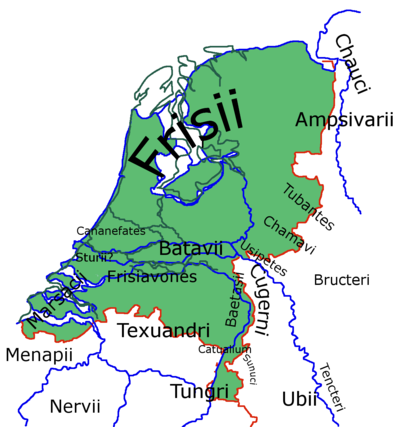

Ampsivarii
The Ampsivarii were a Germanic tribe in modern day North-Western Germany on the border of the Netherlands. They were neighboured by the Frisians in the West, Tubantes to the south and the Chauci in the North.
The meaning of their name is most likely a Latinized version of 'the men of the Ems', this makes sense since they were located around the middle of this river. There is however also a theory that the name is Celtic in origin with the same definition but the Latinized version is the most likely theory.
We do not know much about the history of this tribe. We do know however that the Ampsivarii refused to join Arminius and the Teutoburgerwald battle in 9AD. The Ampsivarii leader, Boiocalus, himself personally declined aid and as a result they were shunned by other Germanic tribes.
Boiocalus instead served Rome and was declared a friend of Rome by the Roman empire. Incredibly enough, Boiocalus ruled for a long time, he managed to lead his tribe for 51 years. In 58AD however, the Chauci wanted to expand westwards and drove the Ampsivarii away from the river Ems.
The Frisians managed to occupy territories along the river Rhine during this whole conflict. They were however driven out again by Roman cavalry and a permanent border was established between Rome and Germania. Boiocalus, who was still alive, asked the Romans for this land but his petition was refused. It seems that the Ampsivarii people were instead invited to join the Roman empire but Boiocalus refused this because he thought it would make him a traitor.
The Ampsivarii asked for help from the Bructeri, Usipetes, Tubantes and Tencteri but the Romans sent in troops and threatened to destroy the Tencteri. The Germanic tribes withdrew and left the Ampsivarii completely alone and without any allies.
Tacitus described the Ampsivarii in his work the Annales.
"Of this same territory, the Ampsivarii now possessed themselves, a tribe more powerful not only from their numbers, but from having the sympathy of the neighbouring peoples, as they had been expelled by the Chauci and had to beg, as homeless outcasts, a secure exile.
Their cause was pleaded by a man, famous among those nations and loyal to Rome, Boiocalus by name, who reminded us that on the Cheruscan revolt he had been imprisoned by the order of Arminius, that afterwards he had served under the leadership of Tiberius and of Germanicus, and that to a fifty years' obedience he was adding the merit of subjecting his tribe to our dominion. "
"The people must submit to the rule of their betters, that the gods to whom they appealed, had willed that the decision as to what should be given or taken from them, was to rest with the Romans, who would allow none but themselves to be judges. This was his public answer to the Ampsivarii to Boiocalus his reply was that in remembrance of past friendship he would cede the lands in question. Boiocalus spurned the offer as the price of treason, adding, "We may lack a land to live in, we cannot lack one to die in." And so they parted with mutual exasperation."
Barely anything more is known about this tribe after these events. Both the Romans and Germanics were now their enemies and they fled up on the river Rhine. Most of the fighting men were eventually killed and the women and children captured by neighbouring tribes. It is thought the tribe went extinct around 60AD but Sulpicius Alexander wrote another history on the Germanic tribes. Unfortunately his work is lost but it has been quoted.
One of these quotes mentions that the Ampsivarii and the Chatti were under control of Marcomer, king of the Salian Franks around 380AD. This seems to imply that not the entire tribe went extinct but that several elements joined up with the Chatti instead. The very last written mention of this tribe is in an official register which lists all Roman units. One Ampsivarii auxiliary unit is described.
Here is an image of a map that shows the location of the tribe and an image of Germanics migrating by Gedau in 1888.
23 notes
·
View notes
Photo

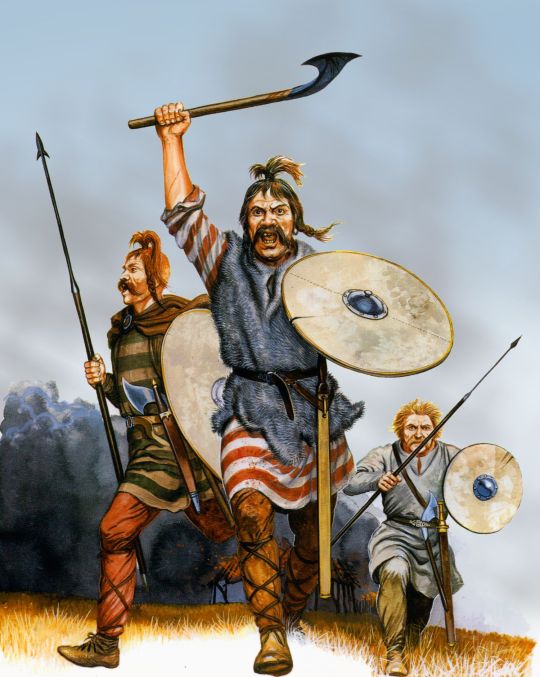
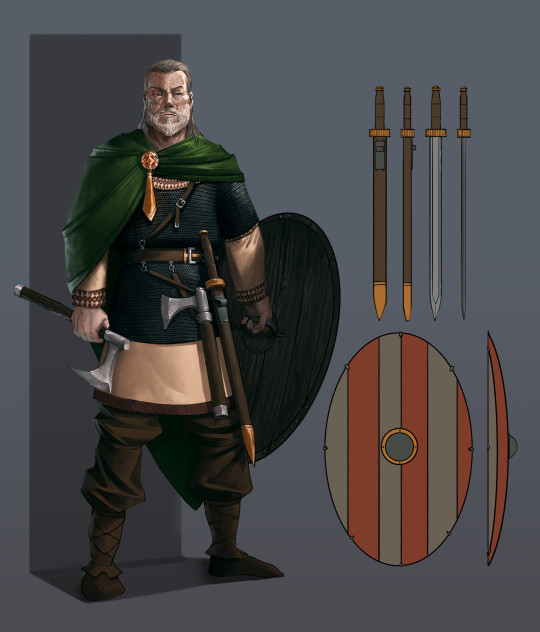
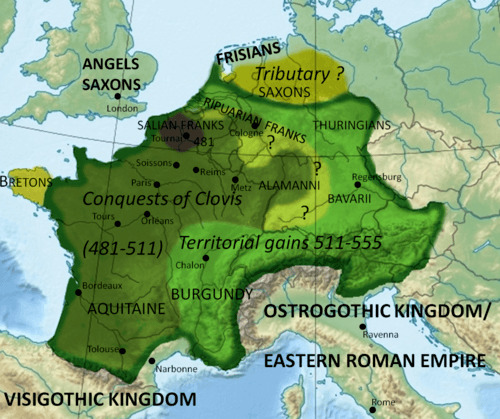
Pre-Christian Franks
Whenever the Franks are discussed, it is usually about the Christian Franks. These Germanic people who laid the foundation for modern France have however a pagan history that I want to share some information about.
The Franks consisted of tribes who originally lived in Scandinavia. They were basically a confederation of several elements from different tribes like the Ampsivarii, Canninefates, Batavi, Bructeri, Chatti, Chamavi, Cherusci, Salians, Tencteri, Tubantes, Sicambri and Usipetes.
It wasn't until the third century that these tribes became known as the Frankish confederation, they were mainly located in modern day Belgium and southern Netherlands. The first time that their name was recorded was in 250AD. A group of Franks took advantage of the chaos in the Roman empire which left it weakened. They invaded the Roman empire and even managed to reach modern day Spain until the Romans expelled them back.
In 297AD however the Franks had a conflict with the Saxons. The Salii, also known as the Salian Franks, were pushed out of their homelands by the Saxons and asked for Roman protection in Batavii lands. This sadly was the end of the Batavi, they ceased to exist as an independant tribe and became part of the Salian Franks.
The Franks also came into conflict with the Celtic people. In 306AD, A Frankish leader named Ascarich, crossed the Rhine river and raided southern Gaul. They were however defeated by the Romans and captured Franks were executed in an amphitheatre, they were most likely ripped apart by wild animals for the fun of the crowd. The Romans retaliated further by attacking the Bructeri in 308AD.
In 358AD, the Salian Franks who fled towards Batavi lands, were accepted by the Roman empire and were granted land in return for military service. The same honour was extended to the Batavi, now part of the Franks. Salian troops were now part of the Roman army. There was also a Frankish chief named Mallobaudes who served in the Roman army. He helped killing the king of the Alemanni in 380AD.
The Frankish confederation started to break in several divisions around 388AD. Now the Salian Franks came into conflict with the Sicambrian Franks. The Salians however won this conflict and the Sicambri were absorbed into one big Salian Frankish group.
Around 400AD, the Franks had crossed the Rhine and permanently settled themselves in Gaul. They were divided into several small kingdoms and were important allies to the Romans. They defended the Rhine territory against other invading Germanic people. The Roman empire slowly started to fall apart and the Franks started to replace Rome as an European power.
This was also the last century in which the Franks were still pagan. This all changed with a new Frankish leader called Clovis I who came into power in 481AD. He was the son of a Salian Frankish king named Childeric of Yssel. Clovis managed to bring all the Frankish kingdoms together into one empire. He converted to Christianity in 497AD and thus the Franks became Christian, this convertion of course took the lives of many Europeans.
The Franks became the largest of the Germanic tribes by not only conquering Gaul but also parts of modern day Germany and Italy. This is seen as the birth of France. Clovis moves the capital of Francia to Paris in 508AD. Paris was formally known as the capital of the Celtic Parisii people.
This is only the start of a rich but violent history of the Christian Franks. I stop this post here because I wanted to talk about the times when they were still pagan. It is interesting to see that Germanic tribes who originated from modern day Denmark and northern Germany, laid the foundation for some of the biggest modern day European countries per example: France, England and Germany.
Here are photos of:
King Clovis I by Arry Scheffer
Illustration of Frankish pagan warriors
A map of the expansion of the Frankish empire
A Frankish warrior art by Alex Scrivener
28 notes
·
View notes
Photo


Cherusci
The Cherusci were a Germanic tribe from Northwestern Germany. The meaning of their name is unclear, they may have been named after the hart or deer, Herut in Proto-Germanic. They are quite a well known tribe because of their participation in the Teutoburgerwald battle.
They were first mentioned in 53BC by Julius Caesar in his work 'De Bello Gallico'. Caesar crossed the Rhine river to punish the Suevi for aiding the Celts. He also mentions how the Cherusci are surrounded by near inpenetrable forests.
In 9AD, Arminius declares that the Cherusci are independent from the Roman empire, after being allied with Rome through treaties. Arminius was the son of a Cherusci chief. He was made a hostage of Rome and raised there as a kid. He became a Roman soldier and was even granted Roman citizenship. He was sent to Germania to aid the local governor in conquering the rest of the Germanic tribes. During this period, Arminius was already planning his rebellion which led to the famous Teutoburgerwald battle.
Three Roman legions were destroyed during that battle. It was a great victory for the Cherusci thanks to alliances with other Germanic tribes like: Bructeri, Chatti, Chauci, Marsi, Tubantes, Tencteri, Usipetes and Sicambri.
The Romans took their revenge. Between 14-16AD, Germanicus led an army back into Germania. (Germanicus was a Roman general) They laid waste to several tribes. No mercy was shown, age and gender did not matter. The Romans burned and killed everyone and everything on their path. It took several battles before the Romans left the area and this time they never came back again and a permanent border was established at the river Rhine.
A few years later in 19AD, war broke out again but this time Arminius attacks Maroboduus of the Marcomanni tribe because Maroboduus did not join Arminius in his fight against the Romans. The battle was indecisive but Maroboduus withdraws back into territory that later became Bohemia. Arminius'son dies in rome as a Gladiator and Arminius himself was assassinated by Germanic nobles in 21AD. These Germanic nobles were concerned about the growing power of Arminius.
Not much is known about the Cherusci after these events. They were at war with several more tribes like the Chatti but war between Germanic tribes was incredibly common. Tacitus did describe the Cherusci in 100AD:
"Dwelling on one side of the Chauci and Chatti, the Cherusci long cherished, unassailed, an excessive and enervating love of peace. This was more pleasant than safe, for to be peaceful is self-deception among lawless and powerful neighbours. Where the strong hand decides, moderation and justice are terms applied only to the more powerful, and so the Cherusci, ever reputed good and just, are now called cowards and fools, while in the case of the victorious Chatti success has been identified with prudence. The downfall of the Cherusci brought with it also that of the Fosi, a neighbouring tribe, which shared equally in their disasters, though they had been inferior to them in prosperous days." (It sounds a bit salty in my opinion)
Eventually the Cherusci were absorbed into the Saxons. They might have played an important factor in the formation of the Saxons.
This tribe left an important Germanic legacy behind, the battle of Teutoburg forest. Some historians call this the most important battle of Germanic/Roman history and the biggest loss of the Roman empire. It had huge consequences afterwards. The battle led to the permanent withdrawal of the Romans in Germania.
Artist of the battle picture is unknown, if anyone knows, please tell me. Second photo is of the Teutoburgwald in the 21st century.
35 notes
·
View notes
Photo



Tencteri
The Tencteri were a Germanic tribe who lived East around the lower Rhine river. Archeologists found Tencteri remains in the Netherlands. Their location is probably modern day south-Germany and East Netherlands.
The Tencteri were first described by Julius Caesar. In 55BC, they were searching for a new homeland and crossed the Rhine river. Celtic tribes who lived in these territories fled. Menapii lands were occupied by the Germanics causing quite some unrest. Julius Caesar feared this unrest because it might provoke other Gauls. He hurried to the area with his army. The Tencteri and Usipetes, sent ambassadors to Julius offering an alliance with the Romans. Caesar refused as long as these two Germanic tribes remained in Gaul.
The negotiations didn't lead to any outcome and eventually the Germanics attacked the Romans, forcing them to retreat. This of course did not sit well with Caesar and he took his revenge. Even after the Tencteri asked for asylum, Caesar with his 8 legions absolutely massacred the tribes in what you can describe as a genocide.
Archeological evidence of this mass slaughter has been found in the Netherlands in 2015. This is also the first concrete evidence that we have of Caesar actually setting foot in the Netherlands. An estimated 150,000 people were killed. In the Dutch village of Kessel, skeletons, swords, spearheads and armour has been found dated to this era.
The tribes however survived this genocide and in 16BC the Tencteri once again crossed the rhine. They battled the Romans who were under command of Marcus Lollius. The Tencteri together with the Sicambri and Usipetes managed to defeat this Roman army and even took a standard of the 5th legion as prize.
The Tencteri have also been mentioned around the time of the Batavian revolt. Veleda, the wise woman, of the Bructeri was called upon to provide arbitration in an argument between the Tencteri and a Roman settlement called Colonia Claudia Ara Agrippinensium (which is now modern Cologne). The Veleda's solution was accepted by both sides. This shows how much influence these wise women had.
Not much later in 69AD the Tencteri joined the Batavian revolt, two Roman legions were lost in the conflict which lasted until a peace had been accepted by Civilis.
Around 150AD Ptolemy, an Egyptian born mathematician, astronomer and geographer, mentioned the Tencteri tribe as well. He placed the tribe's location in the same location as Tacitus did, to the east of the Rhine river. He also mentions a fortress called Asciburgium which is located between the Bructeri and Tencteri. Tacitus has also described this fort and stated that it had been originally built by the God Thor.
Eventually the Tencteri were absorbed into the Franks around the third century. During the great migration period, they did not move from their homeland.
photo of the map by Karwansaray Publishers
26 notes
·
View notes
Photo


Chamavi
The Chamavi were a Germanic tribe from modern day Netherlands. They lived to the north of the lower Rhine river. The location in which they lived is actually still named after the tribe, Hamaland in Gelderland, the Netherlands.
The name Hama(land) comes from Chamavi and it has several possible meanings. It either means Hamu (old high german) which means lame or incomplete, Hamme (Low German) an enclosed piece of land or Hamu/Hemd (old High German/Dutch) meaning a piece of clothing.
Velleius Paterculus, a Roman historian, described how Tiberius crossed the Rhine in 4BC and attacked the Chamavi, Chattuari and Bructeri, This is the first mention of the tribe.
Tacitus also mentioned the Chamavi in his work Germania. He wrote how the Chamavi and the Angrivarii tribe relocated into the lands of the Bructeri around 100AD.
"The Bructeri, but the general account now is, that the Chamavi and Angrivarii entered their settlements, drove them out and utterly exterminated them with the common help of the neighbouring tribes, either from hatred of their tyranny, or from the attractions of plunder or from heaven's favourable regard for us. It did not even grudge us the spectacle of the conflict.
More than sixty thousand fell, not beneath the Roman arms and weapons, but, grander far, before our delighted eyes. May the tribes, I pray, ever retain if not love for us, at least hatred for each other, for while the destinies of empire hurry us on, fortune can give no greater boon than discord among our foes."
Not much further is known about the Chamavi. Around the 3rd century, parts of the Ampsivarii, Batavi, Chamavi, Chatti, Chattuarii, Cherusci, Salii, Sicambri, Tencteri, Tubantes and Usipetes tribes have formed the federation of the Franks.
The Lex Salica, Laws of the Salian Franks written in the 5th century, carries mentions of the Chamavi living amongst the Franks. These descriptions in the Lex Salica are also one of the earliest examples of the old Dutch language.
By the 9th century, the Lex Chamavorum Francorum, law of the Chamavi Franks, was written. It is the official law under the rule of Charlemange. Paganism started to fade away and the Chamavi people were now absorbed into what we now know as the Dutch population. Only the name of the region Hamaland still exist as a reminder of the Germanic tribe.
Here is a photo of the location of the tribe and the modern day location of Hamaland.
14 notes
·
View notes